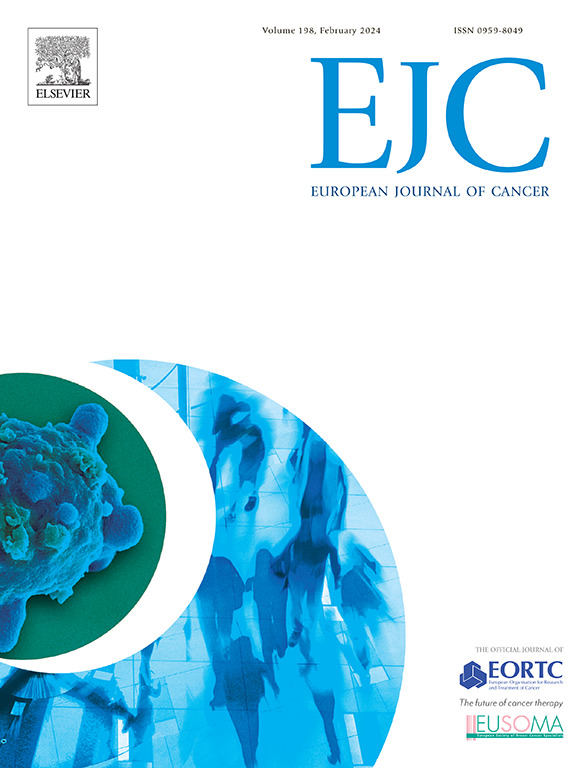Trends and efficacy of definitive radiotherapy regimens for locally advanced head and neck cancer in elderly patients: A population-based analysis by the German cancer registry group
IF 7.1
1区 医学
Q1 ONCOLOGY
引用次数: 0
Abstract
Background
With increasing life expectancy, the number of elderly patients diagnosed with locally advanced head and neck squamous cell carcinoma (HNSCC) is rising. The effectiveness of definitive radiotherapy (RT) regimens in this population remains unclear. This study investigates RT regimen trends and their impact on overall survival (OS) and locoregional recurrence (LRR) in elderly HNSCC patients using a large German cancer registry dataset.
Methods
A retrospective analysis of 84,046 HNSCC cases from 2000 to 2022 was conducted. RT administration trends were assessed in patients aged ≤ 70 years and > 70 years. OS and LRR were analyzed in patients receiving definitive RT alone or combined with chemotherapy (RCTx) or cetuximab (RT-Cet), using Kaplan-Meier estimates and multivariate Cox regression models.
Results
The proportion of elderly patients receiving definitive RT regimens increased significantly over time. Platinum-based RCTx remained the most frequently used regimen but was less common in patients > 70 years than in younger patients (26 % vs. 57 %, P < 0.001). Five-year OS following platinum-based RCTx was comparable between age groups (HR 1.01, P = 0.83). In contrast, RT-Cet was associated with significantly worse OS and higher LRR compared to platinum-based RCTx, with a stronger negative impact in patients > 70 years (OS: HR 2.31, P < 0.001; LRR: HR 2.11, P = 0.003) than ≤ 70 years (OS: HR 1.55 P < 0.001; LRR: HR 1.43, P = 0.002). This age-related difference was not observed with RT alone.
Conclusions
Platinum-based RCTx remains the most effective treatment for elderly HNSCC patients. RT-Cet is associated with poorer outcome particularly in patients > 70 years, underscoring the need for age-adapted, biology-informed treatment strategies.
老年患者局部晚期头颈癌明确放疗方案的趋势和疗效:德国癌症登记组基于人群的分析。
背景:随着预期寿命的增加,被诊断为局部晚期头颈部鳞状细胞癌(HNSCC)的老年患者数量正在上升。明确放疗(RT)方案在这一人群中的有效性尚不清楚。本研究使用大型德国癌症登记数据集调查了老年HNSCC患者的放疗方案趋势及其对总生存期(OS)和局部复发(LRR)的影响。方法:回顾性分析2000 ~ 2022年84046例HNSCC病例。评估年龄≤ 70岁和> 70岁患者的RT给药趋势。使用Kaplan-Meier估计和多变量Cox回归模型,分析接受明确放疗或联合化疗(RCTx)或西妥昔单抗(RT- cet)的患者的OS和LRR。结果:随着时间的推移,接受最终放疗方案的老年患者比例显著增加。铂基RCTx仍然是最常用的治疗方案,但在年龄为0 70岁的患者中,铂基RCTx的使用频率低于年轻患者(26 % vs. 57 %,P 70岁)(OS: HR 2.31, P )。RT-Cet与较差的预后相关,特别是在bb0 70岁的患者中,这强调了需要适应年龄、生物学信息的治疗策略。
本文章由计算机程序翻译,如有差异,请以英文原文为准。
求助全文
约1分钟内获得全文
求助全文
来源期刊

European Journal of Cancer
医学-肿瘤学
CiteScore
11.50
自引率
4.80%
发文量
953
审稿时长
23 days
期刊介绍:
The European Journal of Cancer (EJC) serves as a comprehensive platform integrating preclinical, digital, translational, and clinical research across the spectrum of cancer. From epidemiology, carcinogenesis, and biology to groundbreaking innovations in cancer treatment and patient care, the journal covers a wide array of topics. We publish original research, reviews, previews, editorial comments, and correspondence, fostering dialogue and advancement in the fight against cancer. Join us in our mission to drive progress and improve outcomes in cancer research and patient care.
 求助内容:
求助内容: 应助结果提醒方式:
应助结果提醒方式:


